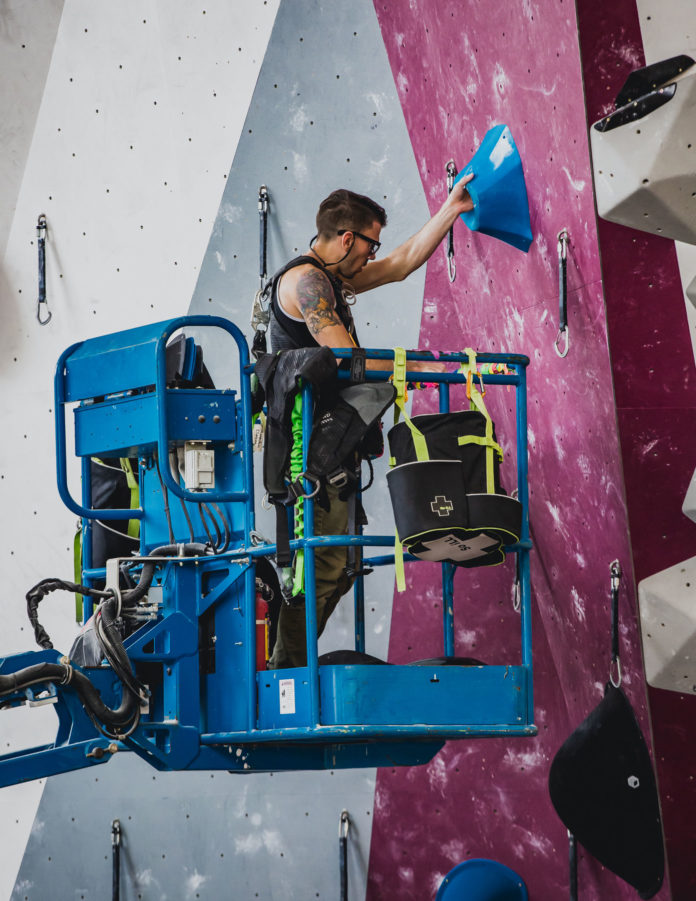
Behind the Desk is a series that interviews people who are part of the climbing industry—those who run companies, manage staff, create innovative new products, and own gyms. This time CBJ dives into USA Climbing’s new partnership with KAYA and the “virtual comp season” that kicked off this month. One of the key persons behind the scenes for that is John Oungst. But that novel partnership is just part of a much larger and inventive path for longtime climber and career routesetter Oungst.
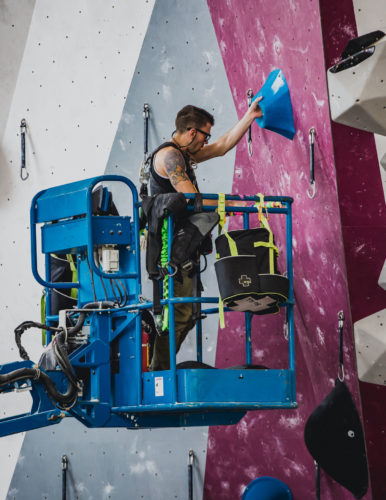
Name: John Oungst
Title: Customer Success Manager
Company: Kaya Climb
CBJ: You have worn a lot of hats over the years. But can you tell me a little bit about how you first got into climbing—and what you consider to be the highlights of your time in the industry thus far?
OUNGST: I discovered climbing when I was really young. My family was a big camping family and we’d go almost every summer for vacation. There was a cliff in the state park that my dad would take us to, set up a top rope anchor, and belay us as kids. But I really got back into climbing in high school. A friend and I went to our local gym and took a top rope belay class. I was hooked. That first year I’m pretty sure I climbed 5-6 days a week. While I can’t even fathom how I did that, I’ve been climbing ever since.
Honestly, I consider my entire routesetting career to be one giant highlight. When I look back at everything I’ve done and all the people I’ve met along the way—it’s been such an amazing experience. Even on the days where the job sucked, like really sucked, I would still go to bed happy because I truly found something I loved. I have never once thought about a career change or a different path. Even when I was barely making it paycheck-to-paycheck (or sometimes not making it!), I still wholeheartedly loved the job and the climbing community, and that feeling always outweighed any negatives. Two specific highlights that really stand out are my first appointment to a USA Climbing National Event, which was Youth Sport and Speed Nationals in 2013, and achieving my Level 5 certification and the subsequent appointment to a National Chief role in 2017.
CBJ: To the point about your various jobs: you’ve been a consultant for a number of gyms. So, could you share what are some of the biggest evolutions you’ve noticed over the years in terms of gym design, construction, and layout?
OUNGST: To answer this question it’s important to look at the trends of the climbing industry as a whole. When I started climbing, gyms were not designed to be these big, beautiful fitness facilities with yoga, youth programs, and cafes. Gyms in the early 2000s were meant to be places for outdoor climbers to seek shelter in the off-season and train. If your gym had more than a janky hangboard set up in the back of the gym where the hold washing station was, consider yourself really lucky.
In the last fifteen years, climbing has exploded in popularity. All those small gyms started seeing more traffic. And gym owners started seeing an opportunity to grow. With this growth, the bigger, the better. Gym design and planning really started to focus on all aspects of climbing—not just the walls. Fitness areas started popping up in new gyms, as did dedicated yoga spaces. From there, as more and more people started hanging out in the gym, gym owners saw opportunities to create social spaces. Cue the bouldering-only gyms next to breweries in the hip parts of town. Climbing is such a social and communal sport that it just makes sense for those things to go together. Who doesn’t love a session with friends at the bouldering gym and then a pint after?
Growth also spurs innovation. Walltopia really was a game-changer for climbing gym design. [Walltopia co-founder and CEO] Ivaylo Penchev saw a way to do it better. I always joked that Walltopia became the IKEA of climbing gyms. They were able to box up an entire climbing gym into shipping containers and then deliver these beautiful, colorful designs. Along with Walltopia, there are many other companies out there dedicating their time to engineering the next best solutions for climbing gyms.
Looking towards the future, I do think the Olympics will play a big part in gym evolution. Well-established gym operators are already opening private or limited-access training centers specifically for their youth teams. If the Olympics does prove to offer a new avenue of climbing growth, I think we’ll continue to see gyms focus more on their youth programs. Even if the Olympics don’t draw new climbers to our sport, there are no signs of climbing growth slowing down (even with the pandemic).
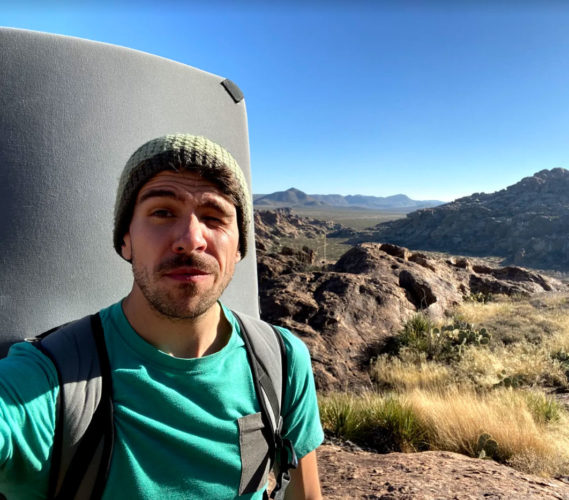
CBJ: You said routesetting is a career highlight. One of the big quandaries for a lot of gyms now is finding that balance between setting the more coordination-heavy, “comp style” boulders that people see on livestreams—and the commercial style of setting. Where do you fall on that spectrum, in terms of personal setting preference. Beyond that, where should gyms fall in their offerings?
OUNGST: The most important thing to remember as a Head Routesetter is that your job is to create and provide a positive experience for your customers. Whether or not you personally like or dislike “comp style” routesetting is a moot point. You can cook the juiciest and most perfectly seasoned burger in your life, but it’ll all be for naught if your customer is vegetarian. You can set the coolest, most badass World Cup boulder of your career, but if the climbers in your gym can’t even pull the start moves, then what’s the point? Finding balance is always important.
You’ve got to listen to your customers—your climbers—and adjust your setting program as needed. If your customer base doesn’t particularly like World Cup-style boulders, perhaps it’s a good idea to reduce that style throughout the gym. While it’s important to listen to your customers, it’s also your job to challenge them. People don’t like change, but I’ve often found when we switched things up—the majority usually warmed up to a new setting style or concept. It’s a dance you’ll have to continually play with your customers—keeping them happy but also pushing them outside their comfort zone. It’s important to remember that any idea you have can be tweaked and adjusted to work for different types of climbers.
If we go back to the World Cup boulder conundrum, try switching up your target audience. Next time you set a World Cup-style boulder, instead of setting a quad-jump-360-down dyno-to a no-hands finish, try setting a very simple volume-only balance climb that any climber can play around on—even a first-time climber in rental shoes. Focus teaching the climber better footwork and balance and challenge the climber to find their own way through the problem. This “World Cup” boulder will still be fun for the experienced climber as well because it doesn’t matter how strong they are—they have to move slowly and maintain balance all the same. We used to set these “Intro” World Cup boulders when I was working for Momentum in Texas, and I would often see a rental-shoe-climber laughing and smiling while trying to work their way through these V0-V1 World Cup boulders. That was always incredibly rewarding for me and my setters to see that—oftentimes it was way more rewarding than watching the gym’s strongest climber smash through our hardest boulder of the day.
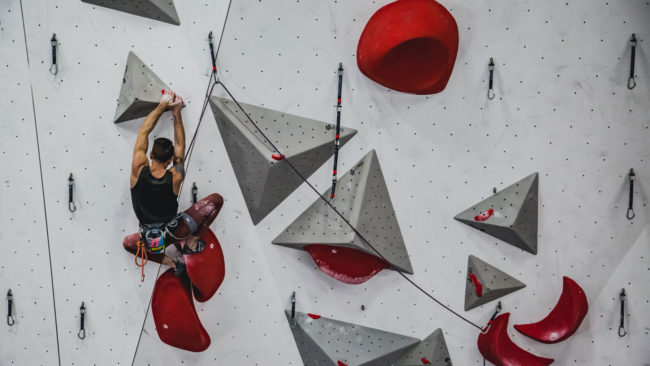
CBJ: I can’t really interview anyone these days and not talk about COVID-19—because it has reshaped our entire world…and certainly the climbing scene. What has your personal experience been like during the pandemic?
OUNGST: Oh, man. 2020 has been especially rough for me on a personal level. I stopped climbing shortly before the pandemic due to some really gnarly headaches. I spent the better part of the year jumping from doctor to doctor to try and figure out what was going on—and it has been quite a ride. Up until three weeks ago, I was not able to climb since the start of February. I was finally diagnosed with a pretty interesting condition: something called a CSF Leak. Basically, my spinal fluid was leaking out through a tear in the membrane that protects your brain and spinal column. Yikes, right? Luckily, it is a very treatable condition and I was able to get a procedure done at the end of August to patch the leak. I finally started climbing and getting back into shape three weeks ago.
I guess in a way, the timing of COVID was quite ironic for me. While I was forced to stop climbing due to medical issues, everything else kind of shut down too—so everyone else had to stop climbing as well. I think that lessened the blow for me being down for the count. It would have been quite difficult to cancel my USA Climbing appointments and instructor opportunities, but because of COVID, they were canceled anyway. I guess it’s really weird when I look back now on how everything played out.
With my career, I had just started in my new role with KAYA back in December. Because of the way our company is operating, I was lucky enough to be able to continue working through the pandemic. It was really, really hard to watch almost all of my friends go through closures, layoffs, etc. Even though I don’t believe we’ve got the pandemic under control, it has been great to see these friends getting back into the gym and safely and responsibly setting again.
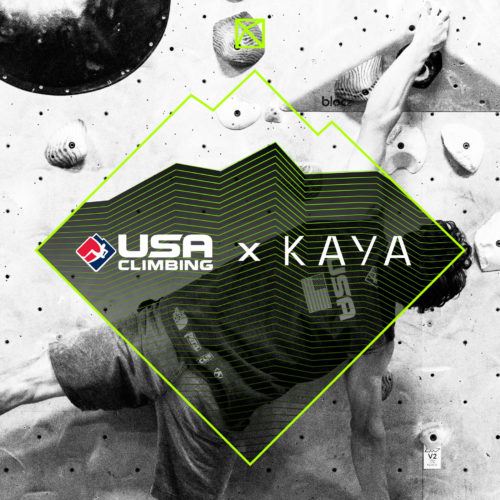
CBJ: You mention your role with KAYA. One of the innovative things to come out of the pandemic has been USA Climbing’s partnership with KAYA for this year’s season. Can you talk about how that partnership came about?
OUNGST: I’m actually very proud of this partnership. I’ve been a part of USA Climbing for almost as long as I have been routesetting, and the organization means a lot to me. I can attribute a lot of my successes as a routesetter to the path I’ve taken with USA Climbing. When I took the role at KAYA, I remember having early conversations with close friends at USA Climbing about the potential for a future relationship. At the time, it was mostly speculative conversation about how “cool it would be to do this or do that.” When COVID hit the country and everything changed, our entire industry had to take a step back and look at the future.
As other sports started hinting at virtual events, USA Climbing was looking into the same concepts—and ways to provide their members and competitors with an avenue to continue participating in sanctioned events. At KAYA, we already had the framework built to be able to run virtual challenges anywhere.
Through the partnership, we’ve been able to provide the tech for USA Climbing to run their virtual events. I’m super psyched that, through KAYA, USA Climbing is offering a competitive season to all those kids who have been eager to get back into climbing again. I’d also be lying if I said I wasn’t nervous. This is totally new territory for all involved and it’s not without its challenges. But I’m confident that the overall experience will be positive and potentially reshape how competitions can be run in the future.
Got a cool story? Tell us!
Do you know somebody who works in the climbing industry and would be good to profile in a Behind the Desk segment? Or, do you work in the industry and have a personal background that you think others would enjoy learning about? If so, please contact us and tell us about it.

John Burgman is the author of High Drama, a book that chronicles the history of American competition climbing. He is a Fulbright journalism grant recipient and a former magazine editor. He holds a master’s degree from New York University and bachelor’s degree from Miami University. In addition to writing, he coaches a youth bouldering team. Follow him on Twitter @John_Burgman and Instagram @jbclimbs. Read our interview Meet John Burgman, U.S. Comp Climbing’s Top Journalist.









